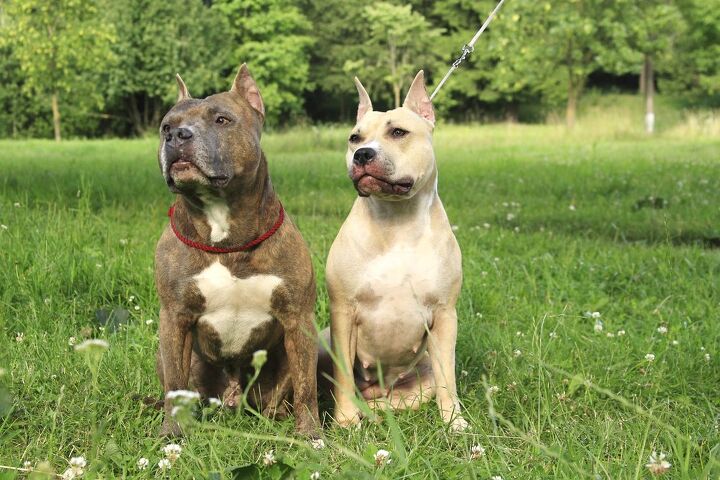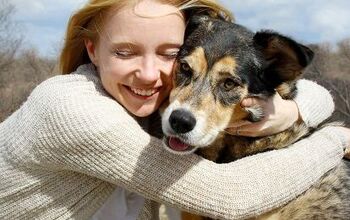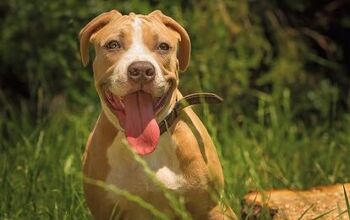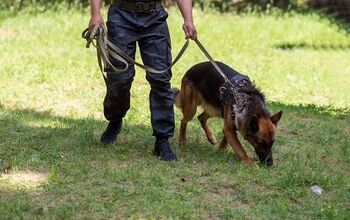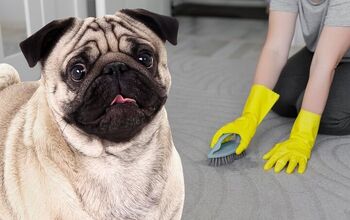American Staffordshire Terrier


About American Staffordshire Terrier
Sometimes it’s important not to judge a pooch by his appearance. There’s more to any doggo than meets the eye. At first glance, the American Staffordshire Terrier can be an overawing breed of dog. This is thanks to the dog’s stocky and muscular build. They look like little tough guys. With its broad head, short muzzle, and demanding jaw bone, it’s no wonder that some people can feel intimidated by this dog. Add to that the American Staffordshire’s thick bone structure, sturdy weight, and scissor bite teeth, and you’ve got one serious dog to contend with. One who can certainly take care of himself in a tough spot. Thankfully, there’s more to the Amstaff than the dog’s rough exterior.
Despite its tough look, the American Staffordshire Terrier is affectionate and loving. This is a pup with a lot of heart hidden within. A wonderful guard dog and a loving family pet, the American Staffordshire Terrier has a sweet side to him, one that made a lot of pet owners fall in love with the breed. Unjustly portrayed as a dangerous dog breed, the Amstaff is a gentle and devoted dog hidden with a muscular and imposing body. So, don’t be so judgmental the next time you see an American Staffordshire. Despite appearances, these doggies are absolute sweethearts and deserve to be treated as such!
Despite its tough look, the American Staffordshire Terrier is affectionate and loving.
The American Stafford Terrier originated in 19th century Staffordshire, England. Developed with a strong muscular build, this breed was initially used for fighting (sad, but tragically true). They were also bred with the purpose of “bull baiting” in their original form. After this barbaric practice was finally banned, these puppers finally got the chance to show their true, affectionate side. Eventually, bull and terrier type dogs finally found their way to America as early as 1870, where they eventually became the unique breed known today as American Staffordshire Terrier. Also, they are known as the Pit Dog, Pit Bull Terrier, American Bull Terrier, Staffy, and Yankee Terrier. When the Cruelty to Animals Act was introduced in the mid 1800’s, these puppers were freed from their harsh life of fighting and baiting. In time, they were described as confident, muscular, good natured and loyal companions, which made them popular not only as dashing and elegant show dogs – but also as affectionate family pets.
The American Staffordshire Terrier became popular in the 1920s thanks to one of these delightful doggos being cast as Pete the Pup in the popular serial Our Gang (aka The Little Rascals). Pete the Pup sparked the interest of viewers all across the United States, and soon after, families all over got to experience the delight of having one of these puppers as a loyal family friend. Sadly, American Staffordshire Terriers today are often connected with the image and subculture of gangsters. Due to their popularity amongst such social circles, the American Staffies continue to be mistreated, and their true, good natured character is discouraged by such reckless owners.
Pedigree
Many people believe that the American Staffordshire Terrier is a result of breeding the White English Terrier, Fox Terrier, or the Black and Tan Terrier with the Bulldog. All of these breeds share similar traits. However, the exact lineage and origin remains unclear. These sorts of things simply weren’t documented when the breed began. Either way, the American Staffy clearly displays the iconic features of these classic English breeds, especially the Bull Terrier. The most prominent of these features is their slender, muscular look that speaks of an athletic and powerful nature. It makes the Staffy an energetic pet and an ideal protector of the household.
The American Staffordshire Terrier was recognized by the American Kennel Club in 1936. It has been a popular show dog ever since, and often seen as a loving family pet. For the initial few decades after it was recognized, the American Staffy was very popular in shows. However, after the Second World War, this breed’s popularity somewhat declined, and is now roughly ranked as 85th in the popularity lists. But even so, it remains an iconic American purebred dog, whose looks are always awe inspiring.
The American Staffordshire Terrier was recognized by the American Kennel Club in 1936. It has been a popular show dog ever since.
To make sure your precious pet stays happy and healthy, you will have to pay attention to their nutrition and make sure that it is up to contemporary standards. Like all dogs, the AmStaff will also require a well-balanced and high-grade diet to stay in top shape. Some pet owners decide to follow the commercial pet food route since it is the best option for most dogs, but others prefer to feed their pups a raw diet or even prepare the meals for their dog on their own. If you happen to prefer basing your dog’s diet on one of these alternative types of nutrition, make sure to consult with a vet. It’s easy to overlook important nutrients- never try to make your dog’s meals without advice from an expert. What is healthy for a human isn’t always healthy for a dog. So it’s important to make sure that your dog’s diet remains nutritionally balanced, even if the individual ingredients are all natural and healthy. Sometimes what a vet recommends might surprise you, so it’s always better to divert to their expertise rather than following the advise of a friend or the internet.
If you want to feed kibble to your pet, there are plenty of options. Some are good, while others are not so good. You will need to feed your American Staffordshire Terrier high-quality dry dog food. Check to make sure that the first ingredient of the food you will be feeding your dog is meat. In terms of nutrients, crude protein should be no less than 30 percent, while crude fat should be no less than 20 percent and fiber content needs to be 4 percent or less. Avoid cheap foods with carb fillers that are full of additives and artificial ingredients. Once you find the perfect formula, make sure it is also appropriate for your dog’s size and activity level (medium or large athletic breeds), as well as their age (puppy, adult, senior). Even if you are going with kibble, it’s a good idea to consult with your vet in regards to brand and portion size. While dog food manufacturers are kind enough to provide useful feeding guidelines, all dogs are different and won’t necessarily fit into that box. Only your vet will be able to determine that personal needs of your specific pup, so make sure to keep them in the conversation before committing to your doggie’s diet.
A diligent pack dog, you need to take an authoritative approach when training your American Staffordshire Terrier.
Since this is a diligent pack dog, you will need to take an authoritative approach when training your American Staffordshire Terrier. This is to gain the respect of the dog and show who is in charge. Start training early in order to establish your alpha status in the relationship. As with most training methods, discipline and consistency are a key. You’ll get the best results if you incorporate methods that allow your Amstaff to please you by doing tasks. This breed loves to please and will eagerly learn something new if it see it pleases you. However, it’s important not to cross the line while establishing yourself as an alpha and disciplinarian. Abuse isn’t training. You must find the right balance and train your American Staffordshire Terrier with a firm, yet loving hand.
Even though it is a natural guard dog, your American Staffordshire Terrier will need to be taught to bark. Believe it or not, barking simply doesn’t come naturally to this breed. When it comes to house training, this will have to be done in a firm manner. As long as your dog knows who is in control, you shouldn’t have any issues training this intelligent breed. They will want to please their master. It’s all about establishing an alpha relationship early and training consistently. Soon you will be amazed by what this pup will do to please you!
Both male and female American Staffordshire Terriers weigh 57 to 67 pounds. These are large and muscular dogs, well known for their physical strength and agility. Of course, this puts them right into the category of large breed dogs, and that sets the ground for a whole new set of rules. First of all, you will need to make sure that your Staffie gets the best possible diet for the breed. That muscle mass has to be maintained! This means a lot of healthy food, in balanced, measured amounts. If you don’t know where and how to start when diet is in question, don’t hesitate to seek out the advice of your vet – they will set you straight!
Thanks to their robust frame and the fact they’ve got a lot of energy to spend, American Staffordshire Terriers don’t have problems with their weight – obese and chubby dogs of this breed are not something you’ll see often. Of course, this does not mean that you should neglect their diet altogether. Healthy food is still a must. Just don’t go over the top. Another important thing related to their weight and size is their need for space and exercise. An American Staffordshire Terrier cannot fully thrive in too confined a space. This means that small apartments and tiny homes will simply not do for these dogs. Your best bet is a spacious home with a fenced-in yard if possible. Staffies simply need to exercise in order to thrive. If you don’t have a yard, then regular hikes and playtime in the park will be mandatory. Regular activity is important for their physical and mental health both!
A protector and pack dog by nature, the American Staffordshire Terrier will fight to protect its family. Once it identifies with its family, the American Staffordshire Terrier will be committed to protecting them. If it feels threatened or thinks its family is being threatened, this dog will become aggressive. As well, the Amstaff is protective of property, which makes it an excellent guard dog. Persistent in its efforts, the American Staffordshire Terrier will not give up in a fight. This dog will protect its family and home, no matter what it takes. This offers good peace of mind for some owners, while coming off as a little intimidating to others. It all depends on what you are looking for in a dog. Still, a lot of this is directly related to the upbringing: if you want your Staffie to grow up friendly and affectionate you will need to take close care to give them a carefree and loving environment to grow up in.
Because it is such a protective breed, the American Staffordshire Terrier must be taught the difference between good and bad strangers. Introduce your dog to friends to teach that they are not harmful. Your American Staffordshire Terrier needs proper socialization with other animals to curb the fighting tendencies. Once they become familiarized with people, this dog will be loving and caring. It is good around children as well, despite the reputation.
Eager to please, the Amstaff will try hard to impress and make its owner happy. Be sure to use this to your advantage when training your dog. It can make a huge difference in whether your end up with a lovable little gentleman or a tiny terror. In the end, it becomes clear that early socialization is key for developing a normal and friendly American Staffordshire Terrier. While they are in their formative puppy years, you will need to introduce them to other dogs, to kind strangers and friendly children. These will be the important first steps in developing a sociable, well-behaved dog later on. And it will work great to break that stereotype that American Staffordshire Terriers are violent brutes from gangster circles.
It may be a hardy dog breed, but the Amstaff can still fall victim to some common canine health problems. One common problem is hip dysplasia, which can cause lameness. Another is congenital heart disease – a dog will be born with this condition, and can either cause symptoms that make the heart work improperly or cause no symptoms at all. You should also watch out for cataracts (another genetic disorder) as well as hives, which often plague the American Staffordshire Terrier due to its short coat.
Still, these issues can be kept at bay or at least postponed with good care and regular checkups. If you make sure that your pet’s diet is healthy and that they get enough exercise, they should remain as strong and athletic as always – and good form is a solid foundation for good health.
American Staffordshire Terriers have a life expectancy of 9 to 15 years. As such, they can be a great pet for a good deal of your life – a true companion. With great care, balanced diet, and regular vet checkups, your Staffy can easily reach the 15-year mark, and perhaps even go beyond it. And in that time, a Staffy’s true temperament can easily establish itself – a character of compassion, companionship, and good nature overall.
Your American Staffordshire Terrier will need regular exercise. These impressive dogs are strong and energetic, so they won’t be content with being a couch potato. OK, some of them might be pleased with getting to nap on the sofa, but it’s not what you should be encouraging them to do. And American Staffy is a lean, tall, and muscular dog breed – with a defined and strong frame. In many ways – they depend on regular exercise. Take your dog on daily walks, make sure they play, and get to be active in general. Frisbees, fetch, track running or jogging by your side are all great forms of exercise, and ideal for spending all that pent up energy. If your American Staffordshire Terrier doesn’t have enough exercise and activities that help him burn off excess energy, he can get fidgety or bored. More often than not, Amstaff boredom leads to destructive behaviors and nervousness, so your furniture or shoes might fall prey to the boredom of your dog. To prevent this, offer puzzle toys, engaging playtime and enough tiring exercise. As a rule of thumb, these dogs will need at least 60 to 90 minutes of daily exercise. Keep them stimulated and tuckered out and these pooches will be absolute sweethearts. Allow them to laze around and grow bored at your own risk!
A protector and pack dog by nature, the American Staffordshire Terrier will fight to protect its family.
The American Kennel Club says this about the breed: “The American Staffordshire Terrier, known to their fans as AmStaffs, are smart, confident, and good natured companions. Their courage is proverbial. A responsibly bred, well socialized AmStaff is a loyal and trustworthy friend to the end.” The breed was accepted by the American Kennel Club quite early on – in 1936. What is more, AKC opened up a special “stud book”, i.e. the breed’s registry, a few times until the 1970’s. This registry ensured that the breed remains pure and ideal in its features. That way the AmStaff can continue to be its jolly old self!
The American Staffordshire Terrier’s coat is short and glossy. Easy to care for, you’ll only need to brush it every once in a while with a firm bristle brush. Its coat can come in a variety of different colors. Since the Amstaff’s coat is thin, it is not well suited for colder climates. This is a dog for warm climates only (although obviously those adorable dog jackets and boots can help quite a bit). What is more, a short coat such as this one makes for easy hygiene. If your staffy gets all muddy in the summertime, a quick hose down will quickly get them clean again. Just make sure they are promptly dried.
Like any kind of puppy, the American Staffordshire Terrier will be hard to resist. It’s just so cute! But don’t let that cuteness distract you – your new addition needs to start training as early as possible in order for it to grow into a healthy and well-adjusted dog. American Staffordshire Terriers are misunderstood because they are often victims of poor socialization and wrong training practices, but with the right approach, these lovely dogs grow up to be wonderful companions. So, to make sure your puppy fulfills his potential, start training at few weeks of age for best results. Those precious early days with your puppy must not be wasted!
Just remember that all puppies are fragile in those first few weeks. Avoid great crowds of eager people, and children that are over-inquisitive. This can cause unnecessary stress on the puppy and even some harm. But as soon as they enter into those goofy and mischievous puppy years, it is time to introduce them to fun, affection, good company, and smiling new faces. It is crucial not to overlook this. Fail to socialize your AmStaff, and you risk them developing many unpleasant behavioral issues.
Photo credit: Kazlouski Siarhei/Shutterstock

Amy Tokic, Editor of PetGuide.com, is a passionate animal lover and proud pet parent of Oscar, a Shih Tzu/Chihuahua cross, and Zed, a Japanese Chin. Her love of animals began in kindergarten, when she brought her stuffed dog Snoopy into class with her every day. Now, she writes about her adventures in pet ownership and tirelessly researches products, news and health related issues she can share with other animal enthusiasts. In her free time, Amy loves perusing used book and record stores, obsessing over the latest pet products available and chasing squirrels with wild abandon (a habit attributed to spending too much time with her pooches).
More by Amy Tokic




